-
Posts
2,123 -
Joined
-
Last visited
-
Days Won
3
Content Type
Profiles
Forums
Blogs
Gallery
Events
Store
Posts posted by Paul L Murphy
-
-
A close up of the signatures.
The only emperor signature I do not have in my collection is the present emperor, Akihito. He still signs the 1st and 2nd class certificates.
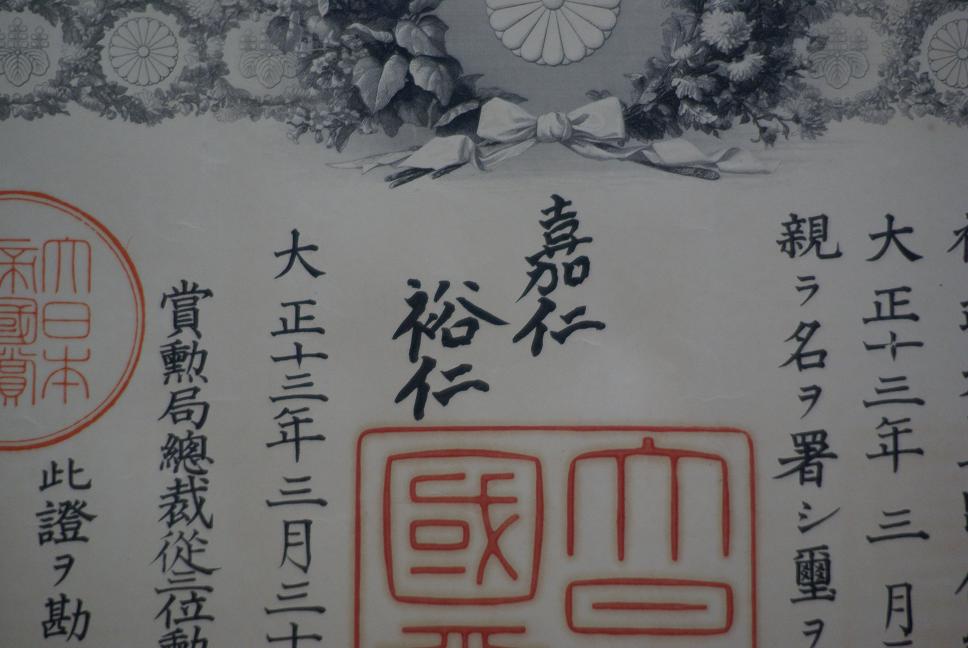 0
0 -
And finally we have the real reason I bought this broken group. This is a certificate for the Sacred Treasure 2nd class. It is issued in 1924 and what is interesting is that it is hand signed by both the Taisho Emperor (the right hand signature) and the Showa Emperor (left hand signature). By this stage I believe Hirohito was acting as regent for his father who was increasingly ill, hence the two signatures. This is an incredibly rare certificate. On it he is a member of the 5th rank of nobility, which was equivalent to a Major General. He eventually retired as a Lt General.
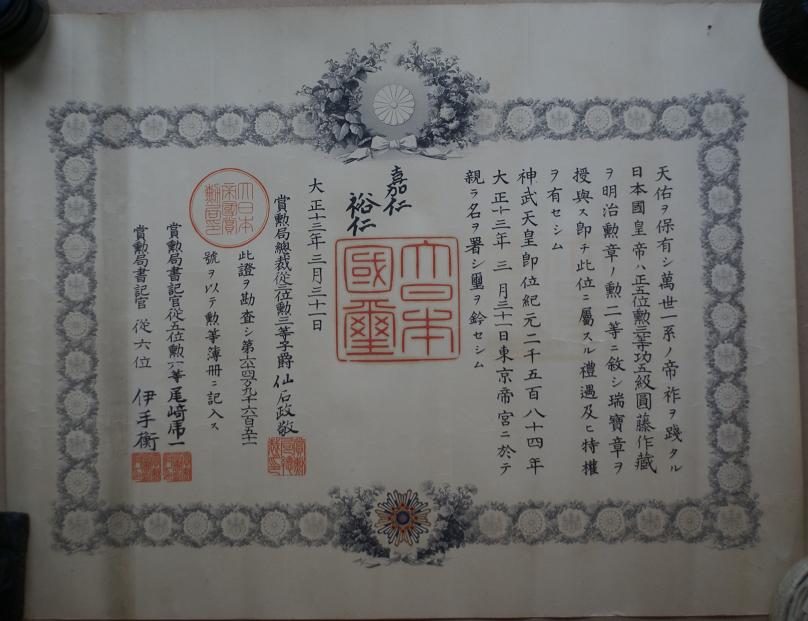 0
0 -
Next up we have his certificate for the Japanese version of the Victory Medal. His ranks and honours are the same as the previous medal.
 0
0 -
Here are some more interesting certificates for your enjoyment. As with so many Japanese groups, it is a broken group (I really wish japanese sellers would realise the value of groups and stop splitting them), however it still contains some nice items. It is to General Endo Sakuzo. I still need to fully research him but he was a divisional commander in the 1920s and retired in the late 20s.
First up is his certificate for the 1914-20 War Medal. On this he is a full Colonel and already the holder of a 3rd class order (Sacred Treasure or Rising Sun) and a 5th Class Golden Kite. The Golden Kite must have been for the Russo Japanese War since that is about the time when he would have been a junior officer.
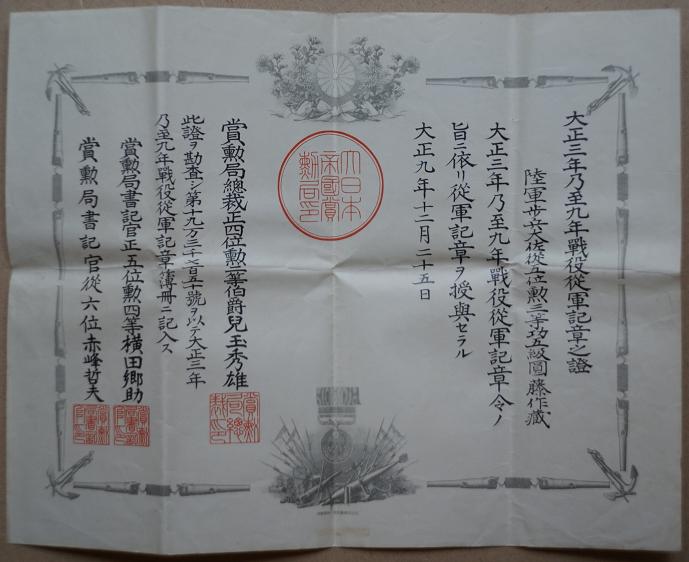 0
0 -
Those documents are very nice!! Paul, as he was awarded the Rising Sun 8th in 1896, could he have also received a medal for the 1st Sino-Japanese war?
It is a distinct possibility. Unfortunately I have no proof either way.
0 -
Regarding routine long service awards-- can you deduce his approximate age from these? He had to have been well older than any of his "peers" in-grade, and coming from "inferior" social background, must have been tough.
I only know German social background for this period, but officers were expected to "fit in" and have sufficient income to provide their own horse and reciprocate "rounds" at the officers' mess, and so on. It would have been an unbearable strain on somebody who ONLY had his salary to live on, as this man must have done.
Never saw ANYTHING on social/class origins of Japanese Imperial forces officers before and wonder if anything on this even exists in Japanese.
Would NEVER have expected this sort of career from anything I've ever read before.

I have a guide in one of my Japanese reference books to the time period they needed to serve for the various ranks and classes of the Sacred Treasure so I need to dig this out.
I am not sure to what extent extra income would have been needed to fund an officer's lifestyle in Japan. I suspect it was a lot less than the British or German armies at the time, especially during wartime. The analogy I would make is that the Russo Japanese War had the same impact on promotion through the ranks as WWI had on such promotions in the British army. A rarity became almost commonplace due to the high casualties and the need to spread experience.
0 -

I am amazed---
How common would it have BEEN to rise from the ranks a century ago? Was he (can you tell from the family name?) a samurai in reduced circumstances or...
defied the class structure? This seems like an incredible life story.
No mention of what units he was in?
Wow.
Hirai is not an uncommon name so it is not possible to say whether his family were Samurai or not. Unfortunately medal certificates do not give unit designations, you need to get some other paperwork such as leave certificates or graduation certificates for this. Sadly there were none with these. I suspect he got a battlefield promotion during the Russo Japanese War. These were not common but I have seen other examples. It was normally long serving senior sergeants or warrant officers that ended up getting them; a reward for service and bravery and it filled a need due to the high casualties among junior officers (a foretaste of what future trench warfare would have in store 10 years later).
0 -
While I cannot read I word, I know how nice and how rare and how special these are. Wow!!
What is missing? Any chance to reunify? (I know the answer, why do I ask, but we must hope, right?)
Almost no chance of reunifying these I'm afraid. What is missing is at least his Russo Japanese War Medal certificate (not sure if he had any other medals, in which case these certs are also missing) as well as a 6th Class and 5th Class certificate for either the Rising Sun or Sacred Treasure since he was 6th rank of honour when he got the Golden Kite and then 5th rank of honour before he got the 4th class Sacred Treasure.
0 -
And to round it off, the other certificate I have belonging to him is a 4th Class Sacred Treasure awarded to him in 1915 as a Captain. Again, this would have been a long service award.

A small and incomplete group but still a very nice one since it shows he served over 20 years, was promoted from the ranks, and won the Golden kite 5th Class.
Enjoy :cheers:
0 -
So far, so what I hear you say. The only unusual thing is the fact that he has the rank of Warrant Officer which does not appear that often.
Well, the next certificate I have is this baby. It is the Order of the Golden Kite 5th Class awarded to him in 1906 for the Russo Japanese War as a 2nd Lieutenant and the two characters in calligraphy in the middle is the hand signature of the Meiji Emperor himself.
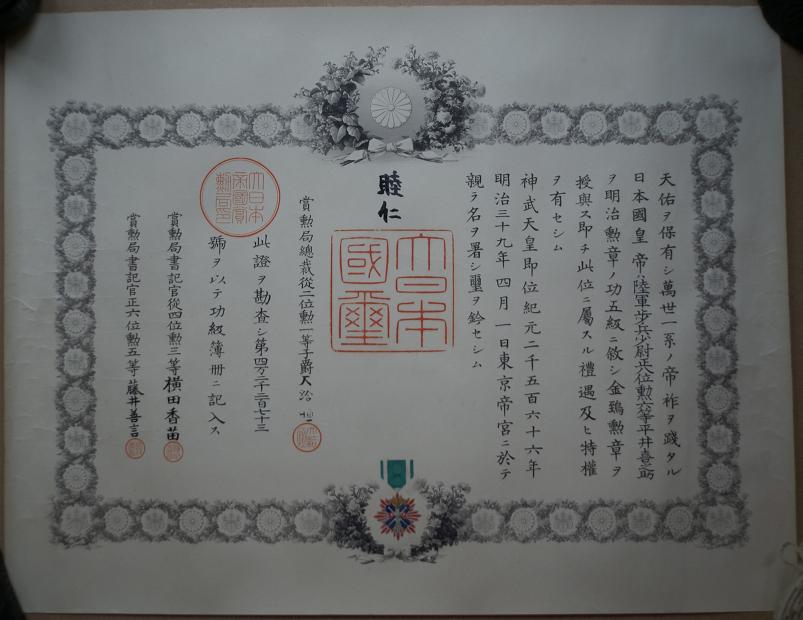
During the Meiji era the Golden Kite certificates down to and including 5th class were all normally hand signed by the Emperor since it was a very prestigious award. For other orders he only signed the 1st to 3rd classes.
0 -
His next certificate is awarded to him in 1902 as a Warrant Officer and it is the Order of the Sacred Treasure 7th Class. This is obviously a long service decoration.
 0
0 -
Here is some nice Japanese eye candy of the paper kind. I have a soft spot for nice groups of documents and while this is unfortunately a broken group (as is so typical of Japanese groups) it is still nice as you will see ...... .
His first certificate is an Order of the Rising Sun 8th Class awarded to him in 1896 when he was a Sergeant 1st Class.
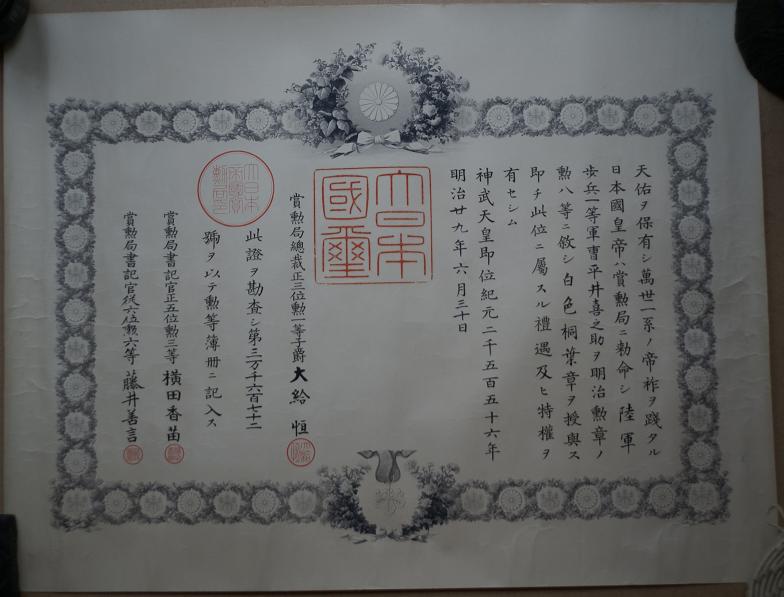 0
0 -
Very impressive! Did you see any mint marks such as the Osaka 'M'?
Thanks for sharing.
Dick
I do not recall any mint marks on it. It is in the bank vault so I will take a closer look when I next have it out.
0 -
Well, on page 140 (3rd ed.), Peterson says "The sash is 106mm wide, of 'morning glory blue' with 18mm edge stripes, and has the usual rosette."
It also tells us that this was only awarded 33 times (1933-40). (Therefore it is rather rare and teh original sahses are not lying around everywhere.)
What else do you wish to know?
Maybe when we get more recent books on Japanaese and Chinese awards, based on more rigorous consultation of the primary sources, there will be more detail?
I have never handled an original sash for this order so I cannot add anything to the description in Peterson (unfortunately).
0 -
I have 1st edition (1967) and 3rd edition (2000) of Peterson, and the illustrations are only in black and white.

It is in colour on the bottom right hand side of the 4th page in the central colour section of the 3rd Edition.
:cheers:
0 -
Have I well understood ??
You have written that : 'The sash badge colours are the same with the "cloud" suspender'.
What do you mean ?
Is the colour of this Sash Badge the plain 'pale green' or is it with some stripes near the edge ?
Have you the possibility to scan the relevant page of the 'Peterson's book published by the OMSA' where this sash is shown ?
Many Thanks
Regards
lilo
What I mean is that the sash badge is the same as the breast star but the suspender from which it hangs is pale green. I am not going to breach OMSA copyright by scanning their book here, if you are interested in Manchurian orders then I would recommend that you purchase a copy of it.
Best regards,
Paul
0 -
Hi Paul,
Can you please let me know which are the colours of the sash badge ?
If you have a photo can you please post it here as a reference or can you post a link where I can see it ?
Many Thanks
Lilo
The sash badge colours are the same with the "cloud" suspender in the same pale green as the small rays. There is a photo in colour in Peterson's book published by the OMSA.
0 -
Paul,
You can contact the NFBA (they have a website for a phone number). They will provide you with a copy of the medal roll if you give them the name and the number on the medal. (There is a number on the rim...right??) They do charge a small fee. In addition to what you know, you will find out the date he qualified for the award. Occasionally there is information on his address, or other extraneous stuff, but not usually. Doyle would have received a bronze medal for his five years service, and they might be able to get you the number of that one and his date of award. The medals were issued as requests came in, and there are no relationships between the numbers on the bronze and silver awards.
Good luck. They have always been very helpful to me, even requests for sending the information to the US.
FireMedals
Yes, there is the number 3039 on the rim. Many thanks, I will give them a try.
Regards,
Paul
0 -
Paul,
You are very lucky fellow to have this in your collection.
A lovely piece, thanks for posting.
What is the stoe in the centre of the star? Saphire, diamond?
Cheers,
James
It is not a stone, it is a small gold ring around the dragon's foot.
0 -
This is a nice silver National Fire Brigades Association Long Service Medal which I got recently. It is named to Bernard Doyle (on the rim), Kimberly Fire Brigade (on the reverse). Does anyone know how to go about researching these since Doyle is an Irish surname and I would like to find out more about him. Also I am presuming that it is Kimberly in South Africa (or is there another Kimberly Fire Brigade somewhere ?) so there could be an interesting story behind this.
http://gmic.co.uk/uploads/monthly_05_2009/post-1487-1241215189.jpghttp://gmic.co.uk/uploads/monthly_05_2009/post-1487-1241215206.jpg
0 -
Nice!
 And those senior Manchuguo awards (not really "Japan") were made in such small numbers.
And those senior Manchuguo awards (not really "Japan") were made in such small numbers.I know. I was going to post it under China but figured it is probably of more interest to Japanese collectors given the nature of Manchukuo. I have not been able to find out if there were further Manchurian awards given between 1940 and 1945, but even if there were the numbers would have been pretty sparse for the higher grades.
0 -
And here is the reverse

Enjoy :cheers:
0 -
With only 33 awards made between 1933 and 1940 this is a very rare award. I do not have the sash badge but here are photos of the breast star which I purchased in Spink a few years ago. First up the obverse
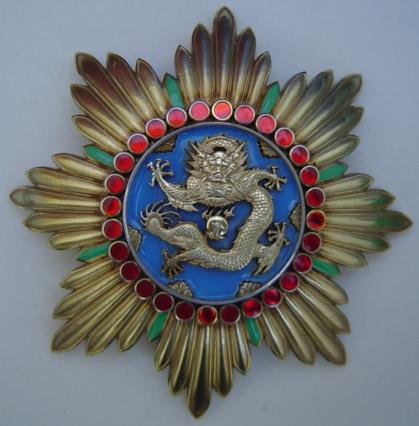
The quality of manufacture is amazing.
0 -
I would not dismiss this as a fake just yet. The examples in the OMSA database themselves show a lot of differences in the quality of manufacture and the planchet of this award is very similar to the style of manufacture of the 6th class piece shown in the OMSA. Their 3rd class piece (which is on the same colour ribbon as this award) is a much nicer made piece, however these were made by a number of different manufacturers so a certain amount of inconsistency in quality is not unusual.
0




More Japanese eye candy in paper !
in Japan
Posted
And a close up of the representation of the Sacred Treasure 2nd Class from the bottom of the certificate. I do have five other documents from Endo, not medal certificates, but they would only be of interest if you could read them since it is the content that is useful in tracing his career.
Enjoy, certificates like this are seldom encountered and as you can imagine are rather expensive when they do come up for sale.